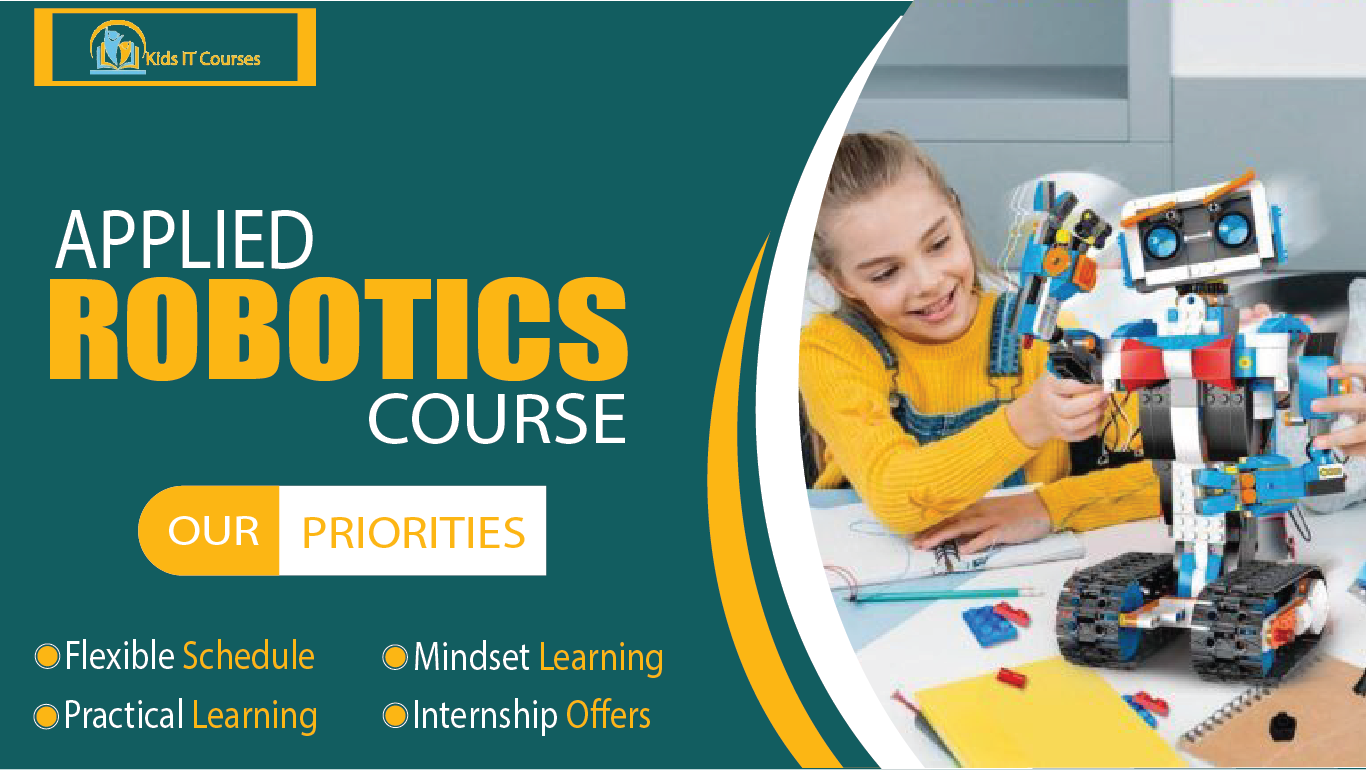
Applied Robotics Course for Kids
Definition
• Kids learn what robots are and how they move and think. It helps them understand the basics of robotics in a fun way.
•They build simple robots using kits and tools. This gives hands-on experience and boosts creativity.
•Kids face small challenges and fix robot errors. It teaches them to think smart and solve problems step by step.
•They learn how to give clear commands and plan robot actions. This sharpens their thinking and decision-making.
• Children use beginner-friendly coding to control robots. This makes learning to code fun and easy.
• They often work in groups to build and program robots. It helps them learn to share, listen, and cooperate.
• Robotics is part of many future jobs and industries. Learning it early gives kids a smart head start.
Importance
• Kids learn what robots are and how they move, think, and follow instructions. It helps them understand real-life machines in a fun way.
• They build and fix robots by thinking through steps. This sharpens their logic and critical thinking.
• Children use simple coding to make robots do tasks. It gives them hands-on experience with modern tech.
• Working on robot projects takes time and careful planning. This teaches them to stay focused and not give up.
• They design robots in different shapes and for fun missions. It blends imagination with science and engineering.
•Many projects are done in pairs or groups. Kids learn to share ideas, listen, and work together.
•Robotics is part of many future jobs and industries. Starting early gives kids a strong foundation in STEM.
Advantages for Applied Robotics Course For Kids
• Kids build real robots using simple parts and tools. This makes science and engineering exciting.
• They learn how to fix issues and think step by step. This helps them become better problem-solvers.
• Children write simple code to control robots. It introduces them to programming in a fun way.
• They design and create unique robots for fun tasks. This encourages creative thinking and new ideas.
• Using tools, sensors, and motors gives them real-world experience. They learn how machines work in daily life.
•Working in groups helps them share and listen. They also learn to lead and cooperate with others.
•Robotics is part of tomorrow’s jobs. This course gives them a strong early start.
Session 1 : Introduction to Robotics & Technology
What is a Robot?
History and Future of Robotics
Real-Life Applications (Space, Medical, Industry)
Basic Components of Robots (Sensors, Motors, Microcontrollers)
Session 2 :Electronics & Circuit Fundamentals
Understanding Electricity & Safety
Basic Electronic Components (LED, Resistor, Battery)
Building Simple Circuits on Breadboards
Intro to Power Supply & Motors
Session 3 : Mechanical Design & Structure
Types of Robot Structures
Design Principles: Balance, Mobility, and Durability
Gears, Wheels, Levers & Movement Mechanics
Hands-on: Build a Simple Chassis
Session 4 : Programming for Robotics
Introduction to Block-Based Coding (Scratch or Blockly)
Logical Thinking & Commands
Programming Sensors & Outputs (e.g. LEDs, Buzzers).
- Hands-on: Code Your First Robot
Session 5 : Sensors & Input Devices
Types of Sensors: Ultrasonic, IR, Touch, Light
How Sensors Work in Robots
Interpreting Sensor Data
Projects Using Sensor Inputs
Session 6 : Robotics with Microcontrollers
Intro to Arduino / Micro:bit / Raspberry Pi (age-dependent)
Programming with Arduino IDE (Basic)
Connecting Inputs and Outputs
Hands-on: Smart Robot Project (Obstacle Avoider / Line Follower)
Session 7 : AI & Robotics Integration (Intro Level)
What is AI in Robotics?
Basics of Decision-Making & Smart Responses
Voice Commands / Facial Recognition (Simplified)
Fun Project: AI-Based Mini Bot
Session 8 : Project Building & Innovation
Design Thinking Process
Team-Based Capstone Project
Project Presentation & Demo
Problem Solving & Innovation Challenge
Bonus Materials:
IoT in Robotics (Smart Home Demo)
- Drone Fundamentals
Robotics in Everyday Life
Ethics & Safety in Robotics
